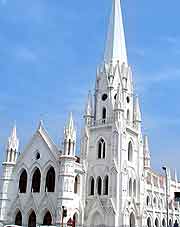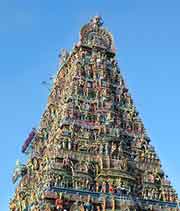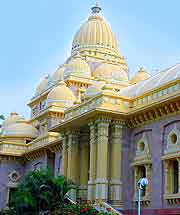Chennai History Facts and Timeline
(Chennai, Tamil Nadu, India)

Formerly known as Madras, the modern city of Chennai has a long history as a settled area, beginning more than 1,000 years ago.
Set on the Bay of Bengal and first developed from the British Fort St. George, the site of the modern city of Chennai was once home to a collection of fishing and agricultural villages. This was before British East India Company merchants Francis Day and Andrew Cogan arrived, setting up a trading post in 1639.
Early Beginnings
Prior to colonisation by the British Empire, almost every South Indian ruling dynasty had reigned over the region's villages and small towns. The first Western arrivals in the Tamil Nadu region were the Portuguese in 1522, followed by the Dutch in 1612. After the British settlement was established on the Bay of Bengal in 1640, the various local villages gradually became incorporated into a single area that was officially renamed George Town, with the growing trading centre and its British residents protected by its fort.

The British Raj
Briefly in 1746, the town was taken over by the French, only to be returned to British control just three years later, following the Treaty of Aix-la-Chapelle in 1748. Subsequently in the history of Chennai, extensive fortifications were installed, ensuring no further interruptions of the East India Company's trade and commerce. By the end of the 18th century, British influence had overtaken the entire Tamil Nadu region and the Madras Presidency had been formed.
Chennai in the 19th Century
Massive development of Madras during the 19th century introduced drastic changes, including a shipyard and base for the British Navy and the arrival of the railway in the later part of the century. This linked the city with Bombay and Calcutta, as well as the vast interior of the country, thus boosting its manufacturing and trading sectors.
One important change in the 19th century was the founding in 1836 of the Madras Chamber of Commerce, which broke the stranglehold of the East India Company on commerce in the city and encouraged new entrepreneurs to open and develop successful businesses. One such business, Spencer's, began as a small shop in 1864 and went on to become the largest Asian chain of department stores in a relatively short time.

Chennai in the 20th Century and Onwards
A crucial development in the early 20th century was the opening of the Madras Stock Exchange in 1920, allowing major Indian business owners and entrepreneurs entry to the mostly closed ranks of the British banking system. Previously, during WWI, Madras had become the only Indian conurbation to be attacked by the Germans, whose battle cruiser SMS Emden sunk a merchant ship in the harbour and shelled the port one night before leaving in a hurry.
Following Indian independence in 1947, the city became the administrative hub of the Tamil Nadu province and continued to attract massive numbers of migrant workers from the interior to its factories, banishing most middle-class Indians and the few remaining former colonists to safer locations.
Even so, the history of Madras, now known as Chennai, remains evident in many colonial buildings and its cultural heritage is celebrated by its countless temples and landmarks.
 Formerly known as Madras, the modern city of Chennai has a long history as a settled area, beginning more than 1,000 years ago.
Formerly known as Madras, the modern city of Chennai has a long history as a settled area, beginning more than 1,000 years ago.
